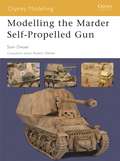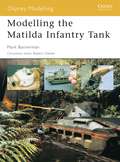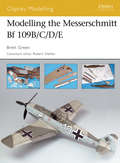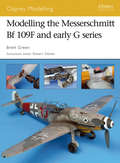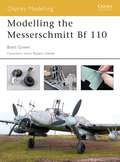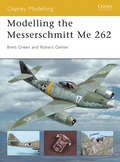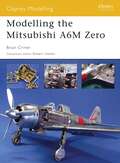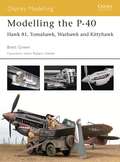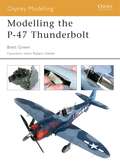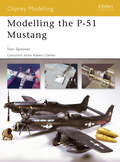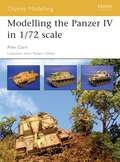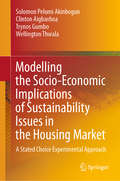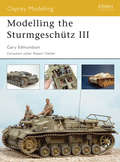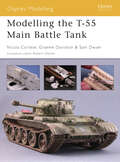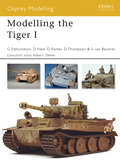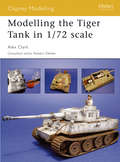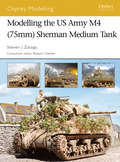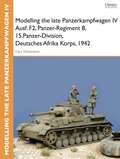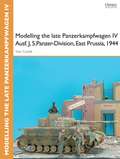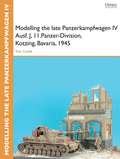- Table View
- List View
Modelling the Marder Self-Propelled Gun
by Samuel DwyerThe term Marder (meaning weasel) was the name given to this family of open-topped tank destroyers. Combining high mobility and heavy firepower, they saw significant combat action in several theatres, This book provides a detailed guide to modelling the Marder in 1/35 scale, and offers diverse challenges to modellers of all abilities. Conversions, interior detailing, kit bashing, adding aftermarket figures and parts, creating different finishes and weathering techniques are all covered in step-by-step visual detail.
Modelling the Matilda Infantry Tank
by Mark BannermanThe Matilda tank saw action in almost all theatres of World War II, from Europe to the Pacific. Born in the interwar years, and developed with numerous modifications following combat testing, the Matilda is perhaps most famous for its role in the desert campaigns of 1940-41, thus acquiring its nickname 'Queen of the Desert'. This book provides a detailed guide to modelling the Matilda tank across a variety of types, colour schemes and scales, and features excellent reference photos. Using clearly explained techniques and methods, and featuring the work of several top modellers, this step-by-step guide to building, finishing and displaying the Matilda in European, Western Desert and Australian service presents a creative and enagaging approach to modelling the 'Tilly'.
Modelling the Messerschmitt Bf 109B/C/D/E
by Brett GreenThe Messerschmitt Bf 109 was the most prominent German fighter type of World War II - over 35,000 were built and it served in many different variants and roles throughout the course of the war. It was the true workhorse of the German Luftwaffe throughout the war and continued in front-line service with some European countries for many years afterwards. This title details the early and pre-war variants, including the Bf 109s that flew in the Spanish Civil War, Poland, France and the Battle of Britain, in a series of increasingly complex construction projects. It also details the numerous kits available of this famous fighter.
Modelling the Messerschmitt Bf 109F and early G series
by Brett GreenUndoubtedly one of the most recognizable fighter aircraft in history alongside the Supermarine Spitfire and the P-51 Mustang, the Messerschmitt Bf 109 is as popular in plastic as in real life. There are almost certainly more kits and accessories of the Bf 109 across the full range of popular scales than any other modeling subject.This second Bf 109 title in the Osprey Modeling series focuses on the Messerschmitt Bf 109F and early G models, the workhorses of the German Luftwaffe during mid World War II. The Bf 109 F, Friedrich, was introduced in late 1940 to counter the increasing dominance of the Spitfire, and formed the backbone of the Luftwaffe during the invasion of the Soviet Union in 1941. The Bf 109G, Gustav, was introduced in early 1942, and became the most numerous of all the 109 variants, as well as arguably the most streamlined.Detailing six different builds across the scales from 1/44 to 1/24, and featuring aircraft in camouflage schemes and markings from the Western Desert to the Russian Steppes, this book is an excellent source of reference for both the beginner and expert modeler, on one of the most effective killing machines of World War II.
Modelling the Messerschmitt Bf 110
by Brett GreenThe Messerschmitt Bf 110 was undoubtedly one of the most significant aircraft of World War II. Despite suffering setbacks in the summer of 1940 at the hands of the RAF, it continued to be used effectively in other theatres and roles until the last days of the war, particularly as a night fighter against RAF Bomber Command's strategic bombing campaign over the Reich. This title shows you how to correct and convert basic 1/48-scale kits of the Bf 110 into many different variants, using a wide selection of aftermarket detail sets, conversions, accessories and decals for both day and night fighter schemes.
Modelling the Messerschmitt Me 262
by Robert OehlerDeveloped from a 1938 design by Messerschmitt the Me 262 Schwalbe (Swallow) was the world's first operational turbojet aircraft. First seeing combat in July 1944, it proved to be particularly effective against the large Allied bomber formations that were operating over Germany late in the war and more than 1,400 were produced, though less than 300 saw combat. This book showcases six different builds of the Me 262 across the scales from 1/72 to 1/32, across a range of skill levels. It also includes a comprehensive list of all the available kits and aftermarket products.
Modelling the Mitsubishi A6M Zero
by Brian CrinerThe A6M Rei Shiki Sento Ki (meaning Type Zero fighter) was the result of an order by the Imperial Japanese Navy for a low-wing monoplane with superior speed, range, climbing powers, and manoeuvrability. It famously served as a fighter escort during the attack on Pearl Harbor in December 1941, and ended the war as the kamikaze plane of choice. This book provides a detailed guide to modelling this popular aircraft across a variety of scales, and features an A6M2-N Rufe, a kamikaze A6M5c, an A6M2 model 21, and a captured A6M5b of TAIC #7, as well as a gallery and walkaround section.
Modelling the P-40
by Brett GreenThe P-40 was a dependable warhorse that provided valuable service throughout World War II. The earliest operational variants were used to great effect by the famous 'Flying Tigers' in China, and the P-40 went on to serve in almost every theatre of the war. Modellers are well served with P-40 variants from major manufacturers and after-market companies, and this book helps make the most of the products available. The projects featured in clear step-by-step detail include a 1/32 'Flying Tiger' P-40B, an RAAF Kittyhawk Mk.IV in 1/48, a TP-40N two-seat trainer in 1/48 and an RAF Desert Kittyhawk in 1/72 scale. Superb colour reference photographs and detailed lists of kits and accessories available round off this authoritative treatment.
Modelling the P-47 Thunderbolt
by Brett GreenThe P-47 Thunderbolt, affectionately nicknamed the 'Jug', was one of the most famous fighter aircraft of World War II. Used as both a high-altitude escort fighter and a low-level fighter-bomber, it quickly gained a reputation for being tough and resilient. Many different air forces operated this plane, and it sported a wide range of camouflage schemes, finishes and markings, including stunning nose art. Modellers have been well served with Thunderbolt kits over the years, right up to the latest highly accurate releases. This book takes a step-by-step approach to modelling a wide variety of P-47 types in 1/48-scale, from 'Razorbacks' in USAAF colours to RAF T-bolts in the Far East. It provides expert advice on conversions (including a Bubbletop to a P-47M), adding aftermarket items, detailing, and ways to achieve top quality weathering and finishes.
Modelling the P-51 Mustang
by Stan SpoonerThe North American P-51 Mustang had a humble genesis as a British request for single engine escort fighter. The projects in the book take the modeller from the aircraft's beginnings to the ultimate manifestation of this elegant and deadly bird, the F-82 G/H Twin Mustang. The North American P-51 Mustang had a humble genesis as a British request for single engine escort fighter. "Dutch" Kindelberger's North American design team created, in just six months, a prototype that would become, arguably, World War II's most important fighter aircraft. The aircraft was designed around the innovative laminar flow wing, which resulted in a much more efficient flow of air across the top of the wing, thereby reducing drag and increasing range. Modelling is the perfect format to appreciate this revolutionary design feature which created a highly maneuverable plane with excellent range. This book pays attention to the crucial details and methods needed to model the Mustang, at differing skill levels and with unique finishing tips and styles - showing the benefits of scratch built components, all illustrated in a clear concise and easy to use manner.
Modelling the Panzer IV in 1/72 scale
by Alex ClarkAlthough not as glamorous as vehicles such as the Panther and Tiger, the Panzer IV formed an extremely important part of the German armoured forces during World War II. This title provides detailed 1/72-scale build articles on a Panzer IV Ausf. H in winter camouflage, a Jagdpanzer IV, a late-version Sturmpanzer IV, a final version Sturmgeschütz IV, and a Flakpanzer IV Wirbelwind. Conversions, interior detailing, kit-bashing, adding aftermarket figures and parts, finishing and weathering, plus special scale techniques are all covered in detail. A gallery section also features Panzer IV Ausf. H, Panzer IV L/70 (V), and Panzer IV L/70 (A) variants.
Modelling the Socio-Economic Implications of Sustainability Issues in the Housing Market: A Stated Choice Experimental Approach
by Clinton Aigbavboa Wellington Thwala Solomon Pelumi Akinbogun Trynos GumboThis book discusses sustainable housing issues in urban areas throughout the Global South, revealing their complexity in terms of urban dynamics, housing markets and human interactions with the environment. Its main focus is on the location of graves within private residences, cemeteries in the immediate vicinity of private residences, and the implications of these factors for renters’ choices and rents. The book addresses the economics of land use for graves in connection with housing choices and the implications for the rented sector of the property market. By means of several model-based simulations, it demonstrates that the neoclassical economics remedy to the negative externality of graves in or near private residences remains generally unacceptable. Providing readers with a clear understanding of tenants’ priorities in their choice of housing, as well as a new approach to the negative externality of graves in the rented sector, the book will be of interest to policymakers, urban planners, investors in residential housing and land economists alike.
Modelling the Sturmgeschütz III
by Gary EdmundsonThe concept of the Sturmgeschutz III started well before the war when the German army announced the need for a self-propelled 75mm gun to be used for infantry support. By 1938, several '0-Serie' prototype vehicles were produced on earlier style Panzer IIIB chassis by Daimler-Benz. The manufacture of the first 30 production vehicles (StuG III Ausf. A) that went into combat in the invasion of France were made at the Alkett factory in Berlin. As the war progressed, the StuG III was continuously improved with variants A through E, and then given a longer, more powerful gun starting with the Ausf. F. The role of the AFV became more diverse, and duties as a tank hunter increased. Some StuG III were allotted to Panzer companies to supplement their losses. Significant changes to the hull were made with the introduction of the Ausf. G, with the later variant of the G being produced right up until April of 1945. The StuG III chassis was also used to house the 10.5 cm Sturmhaubitze 42 L/28 howitzer, of which over 1,200 were produced by Alkett. With the low silhouette and strongly armoured hull, the StuG III proved to be one of the more significant weapons of the German forces of World War II. The book details the construction of four models in 1/35 scale, and includes a gallery feature covering all variants of the StuG III. Aftermarket products are added to the basic kits to produce accurate replicas. References are extensive on this particular vehicle, and are clearly presented as each correction or enhancement to the kits is explained.
Modelling the T-55 Main Battle Tank
by Nicola CorteseThe T-55 tank first appeared in 1958, a result of numerous improvements made to the (1949) T-54 series, and with a lineage stretching back to the wartime T-34 and the T-44. The T-55 series has seen service around the world with many armed forces, including the Warsaw Pact countries, Afghanistan, Angola, Cambodia, China, Croatia, Egypt, Iran, North Korea, Poland, Somalia, Sudan, and Vietnam, and has seen action in key modern conflicts, most recently in the two Gulf Wars. This title showcases the talents of several leading modellers, and presents Serbian, Iraqi, Czech, Syrian, and Russian variants across 1/35 and 1/72 scales. It also features several challenging projects that involve extensive scratchbuilding.
Modelling the Tiger I
by Gary EdmundsonThe Tiger has proved to be one of the most popular modelling subjects of all time, with a vast and ever-increasing range of kits, aftermarket products and references available. Probably the most famous tank of World War II, the Tiger was designed in response to the German Army's fighting experience in Western Europe, North Africa and Russia. Armed with the most powerful German gun, the famous 88mm, the Panzer VI Tiger was intended to dominate the battlefield from the East to the West.In this book, some of the world's most talented modellers cover six separate Tiger projects, their work illustrated by a collection of step-by-step color photographs detailing everything from insignia to battle damage in a variety of combat theaters to illustrate the Tiger's full wartime experience. With varying degrees of difficulty, this will appeal to both experienced modelling enthusiasts and newcomers attempting their first project.
Modelling the Tiger Tank in 1/72 scale
by Alex ClarkThe Tiger tank is probably the most famous tank of World War II. Both the Tiger I and its successor, the Tiger II, were used as bases for other German vehicles. This book covers a wide range of vehicles based on the chassis of the Tiger I and II tanks in 1/72 scale. It provides a detailed guide to modelling the basic tank versions as well as the Sturmmörser Sturmtiger (Tiger I variant), Jagdtiger (Tiger II variant) and the Panzerjäger Tiger (P) Elefant tank destroyer. A variety of camouflage schemes are described in depth, and the text covers photo-etched parts, resin aftermarket sets, scratch-building, and the use of figures and groundwork.
Modelling the US Army M4 (75mm) Sherman Medium Tank
by Steven ZalogaThe Sherman tank was the principal US and Allied tank of World War II with more Shermans manufactured than all German tanks combined. Not only were large numbers manufactured, but there was a very wide range of variants powered by different types of engines, manufactured with different types of hulls, turrets and other details. As a result, a M4A1 tank from the Tunisian campaign in 1942 had nothing in common with a M4A3E8 tank from the 1945 campaign in Germany, even if they shared the same name. Consequently, the Sherman has proven to be an enormously popular modeling subject.Due to the enormity of the subject matter, this book is the first of three planned to deal with this tank and its many variants. It covers the early 75mm Shermans and runs the gamut from the US Army in Tunisia in 1942-43, Italy in 1943-45 and NW Europe in 1945. In so doing, it covers the broadest possible range of variants and details. The builds include:1.M4A1, 2/13th Armored in Tunisia 1942/43. This is mainly 'out of the box', and deals with cleaning up and correcting the popular Dragon kit and painting it in desert colors. 2.M4A3, 6th Armored Division, Battle of the Bulge, January 1945: an intermediate level build, correcting and enhancing the Tamiya kit, and dealing with the issue of assembling aftermarket (separately available add-on components) link-to-link tracks. 3.M4A1, 2nd Armored Division, Sicily 1943. This is actually an earlier version of the M4A1 than the first type (2nd Armored having been the first division with the Sherman); an advanced level project using the Formations resin hull for the proper 'direct vision' early hull. 4.M4, 8th Tank Battalion, 4th Armored Division, Normandy, July 1944: the 'super'project, including a number of advanced techniques such as swapping the suspension on the Tamiya kit, applying foliage camouflage, building and painting a turret interior and adding figures to the model.The book also showcases a number of other Shermans already built by the author to demonstrate the variety available.
Modelling the late Panzerkampfwagen IV Ausf. F2, Panzer-Regiment 8, 15.Panzer-Division, Deutsches Afrika Korps, 1942
by Tom CockleThe Panzerkampfwagen IV was the only German tank to have been produced continuously throughout the whole of World War II, going through several upgrades and improvements along the way. With the Panzerkampfwagen III, it provided the backbone of the Panzer Divisions over the years of both victory and defeat. This guide covers the Panzerkampfwagen IV Ausf. F2, Panzer-Regiment 8, 15.Panzer-Division, Deutsches Afrika Korps, 1942. This guide also features a gallery of other Panzer IV modelling projects. Further information for the modeller including a list of museums and collections, further reading, websites and a comprehensive list of available aftermarket products and kits of all scales is also available. This guide forms part of Osprey Modelling 38 Modelling the Late Panzerkampfwagen IV ebook.
Modelling the late Panzerkampfwagen IV Ausf. H 'Frühe' version, 4.Panzer-Division, Russia 1944
by Tom CockleThe Panzerkampfwagen IV was the only German tank to have been produced continuously throughout the whole of World War II, going through several upgrades and improvements along the way. With the Panzerkampfwagen III, it provided the backbone of the Panzer Divisions over the years of both victory and defeat. This guide covers the Panzerkampfwagen IV Ausf. H 'Frühe' version, 4.Panzer-Division, Russia 1944. This guide also features a gallery of other Panzer IV modelling projects. Further information for the modeller including a list of museums and collections, further reading, websites and a comprehensive list of available aftermarket products and kits of all scales is also available. This guide forms part of Osprey Modelling 38 Modelling the Late Panzerkampfwagen IV ebook.
Modelling the late Panzerkampfwagen IV Ausf. J, 5.Panzer-Division, East Prussia, 1944
by Tom CockleThe Panzerkampfwagen IV was the only German tank to have been produced continuously throughout the whole of World War II, going through several upgrades and improvements along the way. With the Panzerkampfwagen III, it provided the backbone of the Panzer Divisions over the years of both victory and defeat. This guide covers the Panzerkampfwagen IV Ausf. J, 5.Panzer-Division, East Prussia, 1944. This guide also features a gallery of other Panzer IV modelling projects. Further information for the modeller including a list of museums and collections, further reading, websites and a comprehensive list of available aftermarket products and kits of all scales is also available. This guide forms part of Osprey Modelling 38 Modelling the Late Panzerkampfwagen IV ebook.
Modelling the late Panzerkampfwagen IV Ausf. J, II.Panzer-Division, Kotzing, Bavaria, 1945
by Tom CockleThe Panzerkampfwagen IV was the only German tank to have been produced continuously throughout the whole of World War II, going through several upgrades and improvements along the way. With the Panzerkampfwagen III, it provided the backbone of the Panzer Divisions over the years of both victory and defeat. This guide covers the Panzerkampfwagen IV Ausf. J, II.Panzer-Division, Kotzing, Bavaria, 1945. This guide also features a gallery of other Panzer IV modelling projects. Further information for the modeller including a list of museums and collections, further reading, websites and a comprehensive list of available aftermarket products and kits of all scales is also available. This guide forms part of Osprey Modelling 38 Modelling the Late Panzerkampfwagen IV ebook.
Models and World Making: Bodies, Buildings, Black Boxes
by Annabel Jane WhartonFrom climate change forecasts and pandemic maps to Lego sets and Ancestry algorithms, models encompass our world and our lives. In her thought-provoking new book, Annabel Wharton begins with a definition drawn from the quantitative sciences and the philosophy of science but holds that history and critical cultural theory are essential to a fuller understanding of modeling. Considering changes in the medical body model and the architectural model, from the Middle Ages to the twenty-first century, Wharton demonstrates the ways in which all models are historical and political.Examining how cadavers have been described, exhibited, and visually rendered, she highlights the historical dimension of the modified body and its depictions. Analyzing the varied reworkings of the Holy Sepulchre in Jerusalem—including by monumental commanderies of the Knights Templar, Alberti’s Rucellai Tomb in Florence, Franciscans’ olive wood replicas, and video game renderings—she foregrounds the political force of architectural representations. And considering black boxes—instruments whose inputs we control and whose outputs we interpret, but whose inner workings are beyond our comprehension—she surveys the threats posed by such opaque computational models, warning of the dangers that models pose when humans lose control of the means by which they are generated and understood. Engaging and wide-ranging, Models and World Making conjures new ways of seeing and critically evaluating how we make and remake the world in which we live.
Models as Make-Believe
by Adam ToonScientists often try to understand the world by building simplified and idealised models of it. Adam Toon develops a new approach to scientific models by comparing them to the dolls and toy trucks of children's imaginative games, and offers a unified framework to solve difficult metaphysical problems and help to make sense of scientific practice.
Models of God and Alternative Ultimate Realities
by Jeanine Diller Asa KasherThe envisioned volume is a collection of recent essays about the philosophical exploration, critique and comparison of (a) the major philosophical models of God, gods and other ultimate realities implicit in the world's philosophical schools and religions, and of (b) the ideas of such models and doing such modeling per se. The aim is to identify exactly what a model of ultimate reality is; create a comprehensive and accessible collection of extant models; and determine how best, philosophically, to model ultimate reality, if possible and desirable.
Models of Influence
by Nigel BarkerA Collectible Anthology of the 50 Most Inf luential Models in Fashion HistoryIn Models of Influence, photographer, television host, and fashion authority Nigel Barker profiles fifty of the most noteworthy models from the 1940s to the present, revealing how their look or way of modeling not only made an indelible stamp on the industry but also influenced fashion design, the popular way of dress, and notions of female beauty worldwide.Each of the book's eight chapters focuses on a distinct period, from the postwar modeling boom, which ushered in an era of models who communicated a return to glamour, to the present day, with the emergence of media-savvy models who understand the power of branding themselves to the world at large. Each entry highlights the model's background and career, exploring her unique qualities and the secret to her staying power, whether it's her physical characteristics, daring approach to image making, transformative abilities, or a particular energy that captured or even redefined the zeitgeist of fashion and culture of the time.To complement the text, Barker has personally selected more than one hundred full-color and black-and-white photographs from the archives of the world's top fashion photographers--Richard Avedon, Irving Penn, David Bailey, Francesco Scavullo, Herb Ritts, and Mario Testino among them--to assemble a collectible anthology of many of the finest fashion images from the last seventy years.With an engaging, informative text and a vivid collection of seminal photographs, Models of Influence is the definitive word on the subject.With 110 full-color and black-and-white photographss, Models of Influence is a celebration of fashion and a group of unforgettable women who have helped shape and change modern culture.
